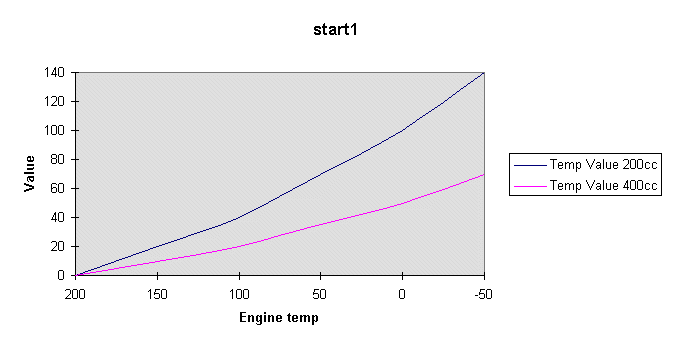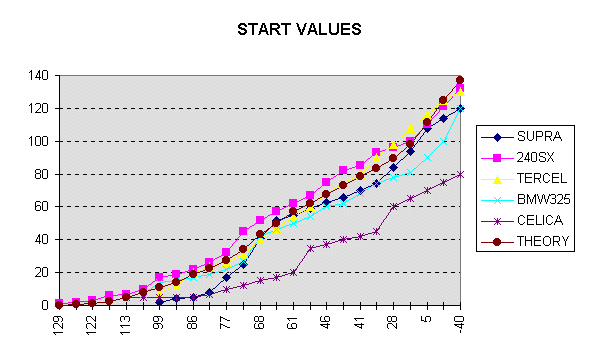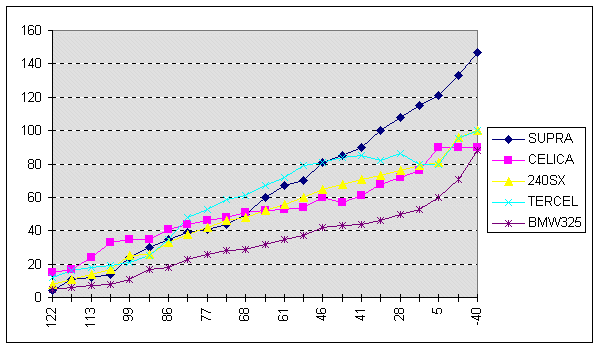| What's Hot! | Products/ Tools | EFI Tuning | Basic Tuning | Advanced Tuning | Chassis Tuning | Advertise with us |
Engine Start-Up Tuning
Programing in a proper start map from timing, ignition, and fuel
Contributed By: SDSEFI
Start and Warmup Programming
Background
Information Gasoline does not vapourize as easily at cold temperatures as it does at warmer temperatures. When the metal parts of an engine are cold and fuel hits them, the fuel tends to condense rather than vapourize. As fuel and air need to be in the proper proportions to combust properly, this fuel puddling problem leads to lean and rich regions in the mixture which are difficult to ignite. Generally, the mixture is extremely lean by the time it reaches the combustion chamber because much of the fuel has condensed and puddled in the intake manifold and ports, not reaching the chamber. Because of this phenomena, we have to increase the amount of fuel injected to ensure that enough fuel reaches the chambers to bring the mixture into its ignitable range.

The chart above shows two hypothetical curves for start or engine temp values.Notice that the values increase at colder temperatures. Please note the graphs below. Actual values may vary considerably from theoretical ones!
Programming Theory
On the SDS EM-3, you can program the number of start cycles from 0 to 255. The larger this number, the longer the start enrichment will last. The larger the start value, the more fuel is injected at that temperature. One engine may require fuel enrichment during cranking and startup to last for a long time while the next engine may need it to last less time. Only trial and error will tell. Once the start cycles are over, the ECU reverts to the engine temp values to supply a richer mixture as the engine warms up. These are also programmable. As the engine warms up, the ET values will decrease to 0 at about 140F on most applications as the fuel is vapourizing normally at this temperature and no extra fuel is required.
Programming Practice
If your engine starts well but stalls after a few seconds, generally the start values are OK but the ET values are too low. You only get one try per starting attempt to set the number of start cycles and start fuel values so this may take some time to set up. For ET values, you can often set these quite well in one sitting by using the following procedure:
Start the engine and call up Gauge 1 mode to monitor the ET. As the ET changes, move the mixture knob slowly richer until the engine begins to stumble, now lean it slowly until you get a stunble again. If the the knob can be turned about the same amount on either side of the 0% mark before encountering a stumble, the ET value at that temperature is close. If you just turn the knob a few percent lean and it stumbles, the value at that ET needs to be slightly higher. Scroll to the ET values and change the one at the current ET to compensate. Once you have accessed the ET values, you can flick back to Gauge 1 by pressing the gauge button once to wait for the system to latch the next ET. Repeat the knob procedure at each ET and flick back to ET values quickly by pressing gauge.
When everything is set correctly, the engine should start quickly and warm up and drive off without any stumbles. The fast idle option will allow easier warmup on MAP equipped systems and is highly recommended. On TP systems, starting may be aided by pumping the accelerator. This activates the accelerator pump function and the ECU will use the higher TP value as the throttle is opened rather than the lower closed throttle value. Starting a TP system therefore may involve a bit of a technique as well as manipulation of the start and ET values. With a MAP system, the ECU will use the relatively high MAP values at the cranking manifold pressure which is usually near atmospheric. This automatically richens the mixture considerably during cranking as the primary pulse width is generated by MAP multiplied by RPM values.

ENGINE TEMP VALUES in the graph below

How fuel vaporizes, the injector spray pattern, cranking speed, cranking vacuum and the head/manifold design all have an effect on the fuel required to start and warm up properly. These factors vary widely between engines so the values required are unpredictable. We present these graphs as a rough guideline.
***Remember*** to check for other relevant information in the columns and article tables.
ATTENTION READER:
If you enjoyed the information and article you just read be sure to check out our newly released book with even more exciting photo's and information:How to Turbocharge and Tune your Engine

Want to know more about your particular Make and Model vehicle? All of these vehicles are covered in the tech, maintenance and repair articles found above. Enginebasics is the wiki or wikipedia of car part, repair, how to and tuning information. Let us be the class 101 for your automotive learning.
| Ford | General Motors GM | Pontiac | Jaguar | Land Rover | Nissan |
| Toyota | Honda | Lexus | Acura | Lotus | Scion |
| Infinity | BMW | Mercedes | Mitsubishi | Ferrari | Maserati |
| Lamborghini | Volks Wagen VW | Saab | Audi | Hyundai | Kia |
| Subaru | Mazda | Chevy | Volvo | Caddilac | Dodge |
| Chrylser | Daewoo | Porsche | Mercury | Freightliner | MG |
Individual Models
| Ford Mustang | Mitsubishi Eclipse | Mitsubishi Evo | Subaru WRX / STI | Dodge Viper | Chevrolet Corvette |
| Nissan Skyline | Honda S2000 | Nissan 350z | Toyota Supra | Chevy Camaro | Lotus Elise Exige |
| Honda Civic | VW Golf | Dodge SRT-4 | Eagle Talon | Acura Integra | BMW M3 |
| Nissan 240sx | Porsche 911 | Acura NSX | Honda Accord | Toyota Camry | Toyota MR2 |
| VW R32 | Dodge Truck | Mazda Rx7 | VW Jetta | Sand Buggy | Nissan Sentra |
For the latest Automotive news and stories visit the websites below |
Our feature Build: An AWD V6 Civic




